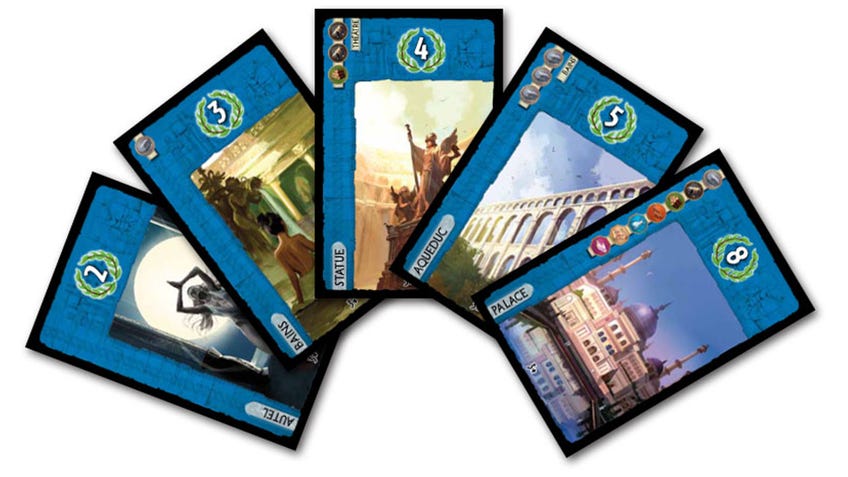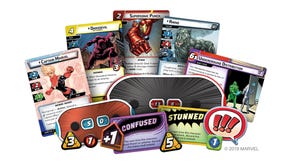How to play 7 Wonders: board game’s rules, setup and scoring explained
Seventh Heaven.
7 Wonders is one of the most popular and influential board games of the last ten years, inspiring games ranging from Sushi Go to Gloomhaven with its clever card-drafting gameplay and simultaneous player turns.
Even 10-plus years on from its release, designer Antoine Bauza’s beginner-friendly board game remains a modern classic in its own right, offering heaps of strategy and player interaction - along with its epic theme of building a civilisation from the ground up - in just half an hour or so.
How to play 7 Wonders
- Player count, game length and overview: How many people you'll need to play, what you'll be doing and how long it will take.
- Setup: Lay the foundations for your civilisation by setting up the game.
- Gameplay rules: It's time to draft, as we get stuck into playing 7 Wonders.
- End of the game and scoring: With the third age over, tally up your score and see if your name will enter the annals of history.
7 Wonders has since been spun off into the equally beloved two-player game 7 Wonders Duel, as well as receiving several expansions that have added new gameplay elements and rules to the base game. If you’ve never played before, though, the original is a great place to start - especially if you’re playing with a group of friends or family.
The game was recently updated with a flashy new second edition to mark its 10th anniversary, but the rules remain the same as before, so you can learn how to play 7 Wonders using this guide regardless of the version you have on your shelf.
Don’t be put off by those symbols and the historical theme - once you know how to play, there’s a very good chance you’ll understand why 7 Wonders is considered one of the best board games of recent years. Let’s get into it.
Player count, game length and overview
7 Wonders by Antoine Bauza is a card-drafting game for three to seven players. It’s recommended for players aged 10+ and has a play time of approximately 30 minutes.
Setup
Start by preparing the age cards. They have the I, II and III numerals on the back.
Separate them into stacks of the different ages (I, II and III) and then go through them to make sure you only keep the ones for the player count you are using. For example, for a three-player game get rid of any that have a minimum player count of 4+ or higher. (Check the card to see which cards are suitable.) Any unused age cards can go back in the box, as they will not be used in this game.
In the Age III stack, you will need to take out all the purple cards to start. Shuffle them together and randomly draw as many cards as the number of players plus two. Add these cards back to the Age III stack and place the rest of the purple cards into the game box. They will not be used this game.
Shuffle the different stacks and place the age cards in the middle of the table within everyone’s reach.

Each player should now get a wonder board at random. These are the seven boards depicting a Wonder of the World. You may notice that the wonder boards are double-sided. You can choose to play on the day or the night side, but for the first game it is recommended you play on the day side.
Give each player three coins. Place them on their wonder boards. The rest of the coins can be placed in the middle of the table to make the coin reserve.
All military tokens can go in the middle of the table. This is the military conflict token reserve.
Any other game components can be returned to the box. They will not be used in this game

Gameplay rules
7 Wonders plays over three ages with each age playing out in roughly the same manner and scoring taking place at the end of the third and final age. Each age comprises six turns that are played simultaneously.
Each turn is split into three stages:
1. Choose a card
At the beginning of each age, seven cards are dealt to each player from the relevant age stack.
You must now all look at the seven cards in your hand and choose one to keep. Place this card facedown in front of you. The remaining six cards should be placed in a facedown stack to your left.

2. Play the card
Once everyone has chosen a card to keep, they all reveal their chosen cards simultaneously.
You can now either:
- Construct the building on your card
- Construct a stage of your wonder
- Sell the card
Constructing the building on your card simply means paying the cost listed on the top left side of the card and placing it in front of you, where it will remain for the rest of the game.
There are four different ways of paying for the construction of a card:
- No cost: If there is no symbol, that card is free and you don’t have to pay a thing.
- Coin cost: In this case you actually need to pay using your coins. You start with three coins at the beginning of the game. There are a number of ways to earn money throughout the game but it doesn’t come easy, so be careful splashing all your cash too quickly.
- Resource cost: There are two different ways of paying using resources:
The first is to look at any buildings already constructed in your city and check the resources they output. For example, if you produce two wood from cards already in your city, you can construct a card costing two wood without paying anything else.
If you don’t have quite enough resources of your own, you can borrow from your neighbours. Unlike games such as Catan or Monopoly, you don’t have to haggle with your neighbours to use their resources - you can simply go ahead, for a price. In order to use a resource from a card owned by a player next to you, you need to pay them. Each resource you borrow costs two coins. You can only use each resource once per turn. You can also only use resources from brown or grey cards, as well as starting bonuses from wonder boards - in other words, you cannot use resources from yellow cards or the wonder board stages at the bottom of the player board. Using a neighbour’s resource does not stop them from using the same resource.

- Free construction via chains: You can pay for the construction of a card through chains. If you have built any buildings with the chain symbol already on and you later want to play a building that shows that same symbol and the name of the building you’ve already constructed next to the cost, you are allowed to ignore the other costs and simply build it for free.
To construct a stage of your wonder you need to look at the cost on your wonder board. Make sure you have the required resources available in your city (on constructed buildings in front of you) and sacrifice the card you have just played by turning it facedown and placing it under the stage of the wonder you are constructing, so that it is still at least half visible to indicate which stages you have constructed. You must build the stages from left to right, without skipping any.
The effect of the stage you have built on your wonder board is available to you for the rest of the game. For example, the second stage of the Alexandria wonder will provide access to either wood, stone, ore or brick for the rest of the game. All effects are listed on the handy double-sided reference sheet that comes with the game.
Your third option is to sell the card, which simply means discarding the card facedown to a discard pile in the middle of the table and receiving three coins. There are a number of reasons why you may want to do this. For instance, if you don’t have enough coins currently to construct any of the cards in your hand or simply want to get rid of a card you don’t want your opponent to get.

3. Pass your cards
The final step of a turn is to take the stack of facedown cards to your left and pass them to the player to the left. Everyone now has a new hand of cards and will follow the steps as before to play out the turn.
You pass to your left during Ages I and III and to the right for Age II. The direction is noted on the back of the Age cards if you need a reminder.
On your sixth and final turn of an age, you will be left with two cards in your hand. You choose one and do exactly the same steps as during the rest of the turns, except instead of finally passing the other card to your neighbour, you simply discard it to the discard pile in the middle of the table.

How to resolve military conflict
At the end of each age the players’ civilisations must fight. To resolve military conflict, you must each count all the military symbols of cards in front of you and compare the total to your direct neighbours on your left and right to determine who has the higher military strength.
- If your military strength is equal to a neighbour, nothing happens.
- If your military strength is higher than one of your neighbours, you receive a military token corresponding to the age you are in: worth 1 point in Age I, 3 points in Age II and a whopping 5 points in Age II.
- If your military strength is lower than both your neighbours you must take a military defeat token, which is the sad token worth -1 point.
Once the military conflict has been resolved, you get to move on to the next age and repeat the three stages: choosing a card, playing the card and passing the cards, followed by military conflict.

End of the game and scoring
7 Wonders ends when you have completed all three ages. At the end of Age III, you tally up your scores using the handy score pad provided.
There are seven sections to the scoring pad, each representing a different way tos core victory points:
- Wonder: Add any victory points from the constructed stages of your wonder.
- Treasury: Each set of three coins is worth 1 VP.
- Military conflicts: Add up points from any military victory tokens, minus the value of any military defeat tokens - it is possible to have a negative score.
- Blue cards (Civilian): The total of any victory points listed on blue civilian cards.
- Yellow cards (Commercial): The total of any victory points from yellow commercial cards here. The value of yellow cards is often dependent on specific criteria. For example, two victory points for each grey card you have built.
- Green cards (Science): Green science cards are the most complicated bit of scoring you’ll have to do. You receive points depending on how many identical symbols you have, taking a look at the chart to tell you how many points you receive. You also earn points for each set of three different symbols you have.
- Purple cards (Guilds): The total of any victory points on the purple guild cards in your city.
The player with the highest score wins. In case of a tie, the player with the most coins wins. If there is still a tie, all tied players win together.



